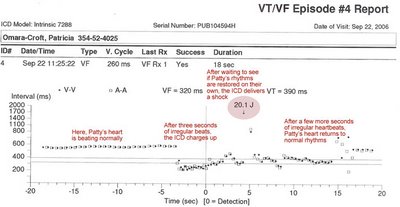As discussed yesterday, Patty's internal cardioverter defibrillator, or ICD, delivered a shock to her heart at around 11:30 am. In the afternoon, we visited Edward Hospital, where they interrogated Patty's ICD -- that is, they read the data recorded on the device to interpret what had happened. They also did blood tests, the results of which we have not yet heard. I was able to get a copy of the strips generated by the device, and can try my best to explain them here. To get a closer look at the chart, please click on it -- you should then see an enlarged version.

If you look at the straight line of dots running from the left of the screen, you'll see what Patty's heartbeat is like when everything is normal. Patty was applying makeup upstairs in our bathroom at this time.
You'll then see that the pattern of dots becomes erratic. At this point, Patty felt a sudden wave of extreme dizziness, and felt like her heart suddenly was beating far too fast. As we learned, it wasn't really beating at all at this point; instead, it was fluttering at more than 250 "beats" per minute. This situation is known as a ventricular tachycardia. When Patty felt this sensation, she started toward her knees because she felt herself losing consciousness. Often, when you hear of athletes suddenly collapsing, they have experienced a similar event.
Patty's ICD recognized that her heart had adopted a dangerous rhythm and, after waiting for four seconds for her heart to restore a normal pace, delivered a 20.1-joule shock to her heart. This is the same sort of process as when doctors apply paddles to a person's chest -- except in Patty's case the "paddles" are wires that extend directly into her heart. Shortly after the shock, Patty's heart again settled into a normal rhythm (as you can see to the right of the strip.)
From initial detection, to shock, to restoration of a normal heartbeat, the process lasted 18 seconds. As I mentioned yesterday, Patty is hoping this never happens again. Although the shock lasted less than a second, it was apparently very painful.
The ICD maintains records of every second since its last interrogation, so doctors can tell what was going on with Patty's heart at any given moment -- although they cannot always tell why. When technicians checked the ICD, they discovered that Patty had experienced a similar tachycardia a week previous (Friday the 15th), but that Patty's heart had resumed a normal rhythm on its own.
I don't really have any more to share about this at this point. We're hoping to hear back from Edward Hospital today with the results of the blood tests, which may be able to provide some answers as to why her heart adopted an odd pattern. We did know that milrinone (the IV drug that Patty carries around with her portable pump) can cause unstable heart rhythms, although it is pure speculation on my part to suggest this may have played a role. More later as we learn it...
Love,
Brian



1 comment:
Wow, getting that sort of shock must have been terrifying. Thank you for posting the medical chart - I appreciate being able to follow what's happening, even when the news isn't great. I'll be praying that this doesn't happen again, and that your heart learns how to behave itself.
Post a Comment